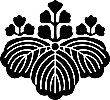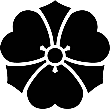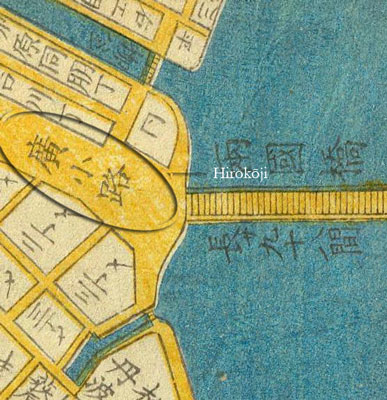
|
|

|
Hokusai - Ehon Sumida Gawa - Prints 1-13 and 1-14

|
|

|
Across the Sumida on the east bank the blue roofed shōgun’s boat sheds arise. In the foreground, in the main street of Hirokōji (廣小路, which literally translates into “spacious lane” or “broad way”) - and following the details of the image from right to left - we first see the north end of Moto Yanagi bridge and then the willow after which it was named.
The willow is located in front of a tea house decorated with fabrics displaying family crests: the blue one on the left is the crest of Toyotomi Hideyoshi, the most powerful lord of Japan before the Tokugawa shogunate; the red family crest on the right is a stylized flower called Kenkatabami:

|

|
| Family crest of Toyotomi Hideyoshi |
Kenkatabami family crest |
Continuing next from right to left we see four priests in print 1-13, a low-ranked samurai holding a parcel wrapped in a cloth (called a furoshiki), and a man carrying a basket full of small watermelons. On the right of print 1-14 a lady is holding a fan with a drawing of three red concentric squares, suggesting that she admires the kabuki actor Ichikawa Danjurō VII. The three concentric squares are the family crest of the Ichikawa family, the most famous family of kabuki actors who were called “Danjurō” once considered ready and able to perform professionally. Around 1800 Danjurō VII was the lead kabuki actor in Edo and here is one of the prints in which this actor has been immortalised (a reproduction made by David Bull).

|
Shibaraku by Utagawa Kunimasa (1796) |
At the time this print was designed, which was 1796, Danjurō VII was still called Ichikawa Ebizo.
Finally, on the left of print 2-14 a man is seen carrying a basket full of gohei (御幣, which literally translates into “honorable Shintō zigzag-paper offerings”). Gohei are wooden wands decorated with two shide (zigzag-shaped paper streamers, see prints 3-12 and 3-13 for details) used in Shintō rituals. Across the river people are harvesting shells in the low water in front of the boat sheds.
The location of Hirokōji relative to Ryōgoku bridge can be seen in this detail of an Edo map published in 1858:

|
Hirokōji on an Edo map of 1858 |